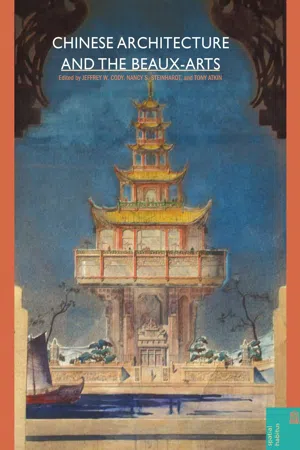
eBook - PDF
Chinese Architecture and the Beaux-Arts
This is a test
- 408 pages
- English
- PDF
- Available on iOS & Android
eBook - PDF
Chinese Architecture and the Beaux-Arts
Book details
Table of contents
Citations
About This Book
No detailed description available for "Chinese Architecture and the Beaux-Arts".
Frequently asked questions
At the moment all of our mobile-responsive ePub books are available to download via the app. Most of our PDFs are also available to download and we're working on making the final remaining ones downloadable now. Learn more here.
Both plans give you full access to the library and all of Perlego’s features. The only differences are the price and subscription period: With the annual plan you’ll save around 30% compared to 12 months on the monthly plan.
We are an online textbook subscription service, where you can get access to an entire online library for less than the price of a single book per month. With over 1 million books across 1000+ topics, we’ve got you covered! Learn more here.
Look out for the read-aloud symbol on your next book to see if you can listen to it. The read-aloud tool reads text aloud for you, highlighting the text as it is being read. You can pause it, speed it up and slow it down. Learn more here.
Yes, you can access Chinese Architecture and the Beaux-Arts by Jeffrey W. Cody,Nancy Shatzman Steinhardt,Tony Atkin in PDF and/or ePUB format, as well as other popular books in Architecture & History of Architecture. We have over one million books available in our catalogue for you to explore.
Information
Table of contents
- Contents
- Acknowledgments
- A Note on Chinese Names and Other Clarifications
- Introduction
- Part I. Divergence to Convergence
- 1. Chinese Architecture on the Eve of the Beaux-Arts
- 2. Just What Was Beaux-Arts Architectural Composition?
- Part II. Convergence to Influence
- 3. Convergence to Influence: Introductory Perspectives
- 4. Chinese Architecture Students at the University of Pennsylvania in the 1920s: Tradition, Exchange, and the Search for Modernity
- 4. An Outline of Beaux-Arts Education in China: Transplantation, Localization, and Entrenchment
- 5. A Classicist Architecture for Utopia: The Soviet Contacts
- 6. Beaux-Arts Practice and Education by Chinese Architects in Taiwan
- Part III. Influence to Paradigm
- Influence to Paradigm: Introductory Perspectives
- Yang Tingbao, Dong Dayou, and Liang Sicheng. Modern and Ancient
- 7. Yang Tingbao, China’s Modern Architect in the Twentieth Century
- 8. Between Beaux-Arts and Modernism. Dong Dayou and the Architecture of 1930s Shanghai
- 9. Elevation or Façade: A Re-evaluation of Liang Sicheng’s Interpretation of Chinese Timber Architecture in the Light of Beaux-Arts Classicism
- Lü Yanzhi, Zhang Kaiji, and Zhang Bo. Republican and Early Socialist Politics
- 10. From Studio to Practice. Chinese and Non-Chinese Architects Working Together
- 11. Ritual, Architecture, Politics, and Publicity during the Republic: Enshrining Sun Yat-sen
- 12. The Sun Yat-sen Memorial Auditorium: A Preaching Space for Modern China
- 13. Zhang vs. Zhang: Symmetry and Split: A Development in Chinese Architecture of the 1950s and 1960s
- Chinese Cities. Beaux-Arts Plans and Post-Beaux-Arts Urbanism
- 14. The Beaux-Arts in Another Register. Governmental Administrative and Civic Centers in City Plans of the Republican Era
- 15. Chinese Urbanism beyond the Beaux-Arts
- Afterword. The Four and the Five
- Contributors
- Index